What is it?
Kia really made a mark in the mid-size SUV space with the Seltos, and now, with its compact SUV the Sonet, it’s looking for another mega hit. Like the Seltos, the Sonet is an all-new model for Kia that made its global debut right here in India and will later be sold in other markets.
It shares a platform with the Hyundai Venue, and though you’d expect the Sonet to feel the same from behind the wheel, the two Korean firms take a very divergent approach with their platform sharing. Unlike the badge-engineered or mild-facelift alterations we’ve seen others opt for, Hyundai and Kia have made sure their shared products have little in common. The exteriors and interiors bear no similarity, and both also feel a bit different to drive, thanks to subtle changes to the tuning of the engine and suspension.

There are three engines (four if you count two different power outputs for the diesel) and five gearboxes on offer (yes, that many!) and they are offered in five combinations.An 83hp, 1.2-litre petrol mated to a 5-speed manual, a 120hp, 1.0-litre turbo petrol mated to a 7-speed DCT auto or a 6-speed iMT (clutchless manual), and a 1.5-litre diesel that puts out 100hp when coupled to a 6-speed manual.
The surprise is the 1.5 diesel with a 6-speed torque-converter auto that has its power bumped up to 115hp. It’s also a surprise because a diesel auto is rare in the compact SUV segment and the only such options are those with lowly AMT gearboxes. Even the Sonet’s cousin, the Hyundai Venue, only offers a manual with its 1.5-litre diesel. But what the Sonet doesn’t get is a manual option with the 1.0 turbo-petrol, and that could be a miss for purists. For this test drive, we had the chance to review three powertrain options – the 1.0 turbo-petrol DCT and iMT, and the 1.5 diesel auto.
What’s the Kia Sonet diesel auto like?
Interestingly, the diesel is the same powertrain that does duty in the Seltos, putting out an identical 115hp and 250Nm. The diesel manual gets the fixed-geometry-turbo engine (instead of the variable-geometry unit on the auto) and puts out a lower 100hp and 240Nm of torque.
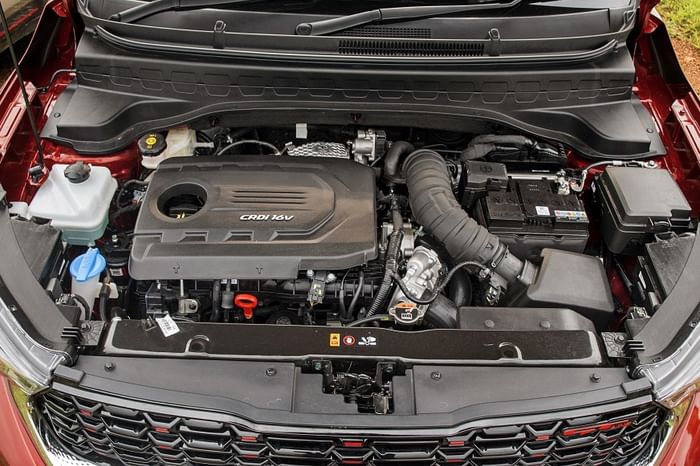
The 115hp engine is an absolute gem. Refinement is top notch, and noise and vibrations are muted. At high revs it does get a bit gruff, but never really sounds harsh or thrashy. Performance, too, is excellent, with very little turbo lag, and once you get past the 2,000rpm mark, there is a step up in power delivery. From then on, you get a satisfyingly seamless surge of power up to 4,200rpm, at which point the gearbox will upshift even in manual mode.
What’s nice is that the auto 'box is really very well matched to the broad torque spread of the diesel powerplant, and in the Normal drive mode, it delivers a very intuitive drive experience. It seldom feels like it’s in the wrong gear and the car does exactly what your right foot tells it to. Try to change pace and it will do so smoothly; put your foot down to overtake traffic and the gearbox will drop just the right number of cogs to give you enough grunt, and, as expected of a torque convertor unit, the power comes in nice and smooth.
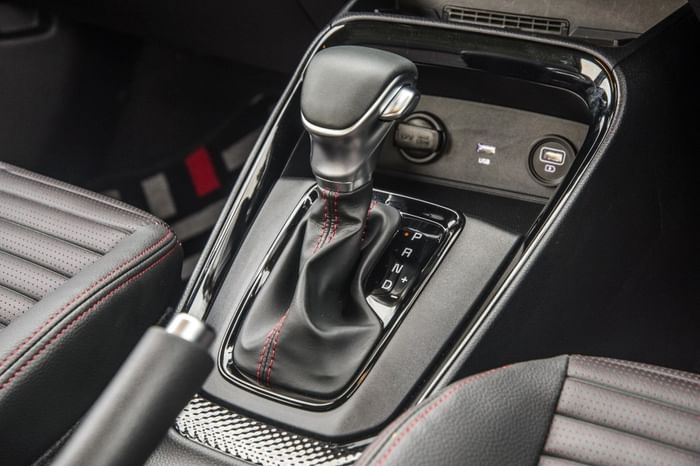
Sport mode, of course, does bring in a more aggressive feel, with the ’box holding on to the lower ratios a bit longer. But so useable and intuitive is the Normal mode that for everyday driving and even some quick dashes, it will prove to be enough for most. There’s also an Eco mode, and here too it impresses, as it turns out to be quite useable and doesn’t throttle the engine in the interest of efficiency.
How about the Kia Sonet turbo-petrol?
The 1.0-litre turbo-petrol is shared with the Venue, and while Hyundai offers it with a manual, DCT or iMT, Kia only offers the Sonet with the DCT and iMT. The engine puts out the same 120hp and 172Nm as the Venue and the all-aluminium unit is nicely balanced, so you can hardly feel the typical thrum of a three-pot motor. Refinement is also very good and it’s only when you rev it to the redline that it gets a bit vocal. The punchy midrange and the ease with which it builds power makes it a fun drive, and while there are no paddle shifters like you get in the Venue, there is a sequential function via the gear lever, so enthusiasts can engage with the gearbox and this feisty engine.
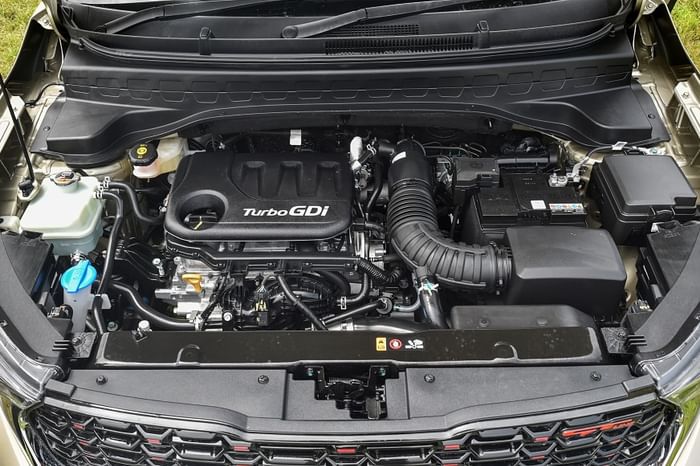
At slow speeds, however, you can trip up the DCT, which isn’t as good as VW’s DSG – the benchmark for mass-volume twin-clutch transmissions (which, ironically, VW discontinued in its mass-market cars). Like in most dual-clutch gearboxes, when you mash your foot down, there’s a momentary hesitation followed by a burst of power. Also, when you’re crawling in traffic, the transmission feels a bit snatchy. All this serves to highlight how much smoother the diesel’s torque-converter transmission is.
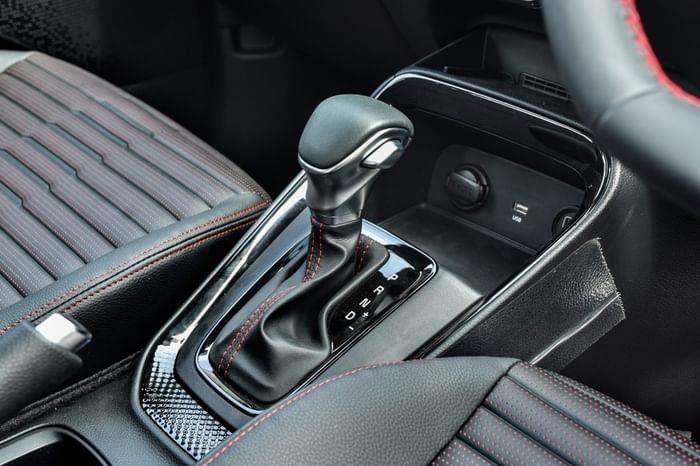
The iMT is also something we got a chance to experience and, compared to the DCT, it offers you better control over shifts, as there’s no software and automated controls to second guess you. So, in theory, you can extract the 1.0 turbo’s maximum performance. However, the iMT gearbox does not like to be hurried, and if you stomp down on the throttle after a quick shift, the car bogs down. This also showed up in our testing, where the iMT was markedly slower than the DCT. If its performance you’re after, then you’ll be better off with the DCT. The iMT makes sense only if you want to have full control over your shifts but without the hassle of a clutch.
What is the Kia Sonet’s performance like?
The diesel auto was the quickest. In a quick test, it did the dash to 100kph in just 11.48sec compared to the petrol DCT’s 12.25sec and 13.37sec for the iMT. The diesel was also ahead in the roll-on acceleration runs, registering 8.09sec from 40-100kph and 6.29sec from 20-80kph. The petrol DCT posted a slower 9.10sec and 7.48sec for the same 40-100kph and 20-80kph runs; being autos, of course, both times were the result of a sharp kick-down on the accelerator in full auto driving. The iMT posted 13.55secfor 40-100kph in fourth gear and 11.19sec for 20-80kph in third gear.
| Kia Sonet performance (as tested)* | |||
|---|---|---|---|
| Sonet 1.0 Turbo iMT | Sonet 1.0 Turbo DCT | Sonet 1.5 Diesel AT | |
| 0-20kph | 1.48s | 1.56s | 1.17s |
| 0-40kph | 3.27s | 3.40s | 2.51s |
| 0-60kph | 6.12s | 5.78s | 4.70s |
| 0-80kph | 9.38s | 8.90s | 7.78s |
| 0-100kph | 13.37s | 12.25s | 11.48s |
| 0-120kph | 19.87s | 17.28s | 15.76s |
| 20-80kph | 11.19s (in 3rd gear) | 7.48s (in kickdown) | 6.29s (in kickdown) |
| 40-100kph | 13.55s (in 4th gear) | 9.10s (in kickdown) | 8.09s (in kickdown) |
So it’s the diesel auto powertrain that delivers a smoother drive experience as well as better performance; who would have thought? Add to this a slightly better claimed efficiency – 19kpl for the diesel, 18.3kpl for the petrol DCT and 18.2kpl for the iMT – and the diesel is quite clearly the better pick.
There is the matter of cost, of course. Diesel autos can get pricey, but with the petrol using costly direct injection and dual-clutch gearbox technology, the gap may not be all that much. In fact, on the whole, so good is the diesel auto, we can’t help but think Hyundai has really thrown away an excellent hand by not offering the Venue with the same powertrain combination.
How is the Kia Sonet’s ride and handling?
Ride quality on the diesel and petrol are both quite similar, the Sonet easily soaked up massive potholes with ease and the fat, 215/60 R16 tyres did a good job of smothering out our rain-ravaged roads. The only negative bit is, over a few sharp ruts, you feel a thud, and it tends to heave you upwards when cresting speed breakers.
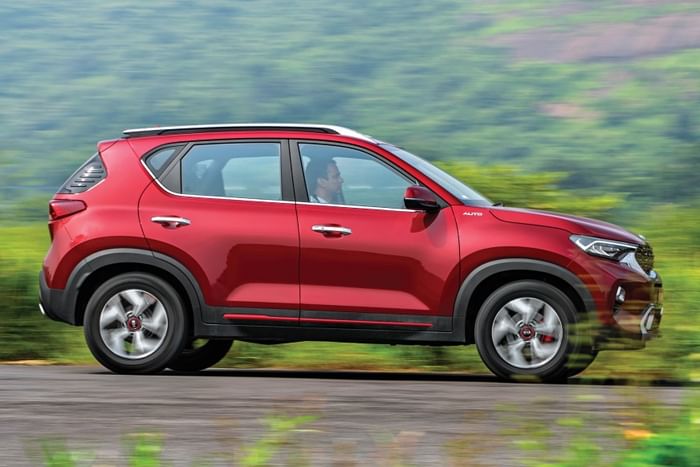
In terms of handling, the diesel and petrol feel a bit different. The diesel has a slightly heavier steering and is a bit more nose heavy. The petrol felt nicer to steer and turned into corners with a bit more agility. Both cars feel nicely planted and offer a great degree of confidence at high speeds, which makes them good long-distance cruisers. Overall grip through corners is good, and body roll is well contained. The steering feel on both is pretty similar – there isn’t much feedback, but on the plus side, it is light enough in the city and has enough weight at higher speeds. The light controls, decent all-round visibility, tight turning circle and compact dimensions make the Sonet very urban-friendly and easy to slot into tight parking spots.
The drive modes do alter the steering feel, though the influence is minimal and only felt in Sport mode, with the steering firming up a bit. Unique to the segment, the Sonet also offers traction modes (Snow, Mud and Sand). We couldn’t get round to testing these, but will certainly go through them in detail in our full-blown road test.
What’s it like on the outside?
We’ve already talked about the design and styling in our first look, but to reiterate, the Sonet does look very much like the concept showcased at the Auto Expo, except for bits like the flush door handles and some trim bits that haven’t made it to production. And while Hyundai has gone with a more radical style for the Venue, Kia has opted for a more familiar but yet very striking approach.
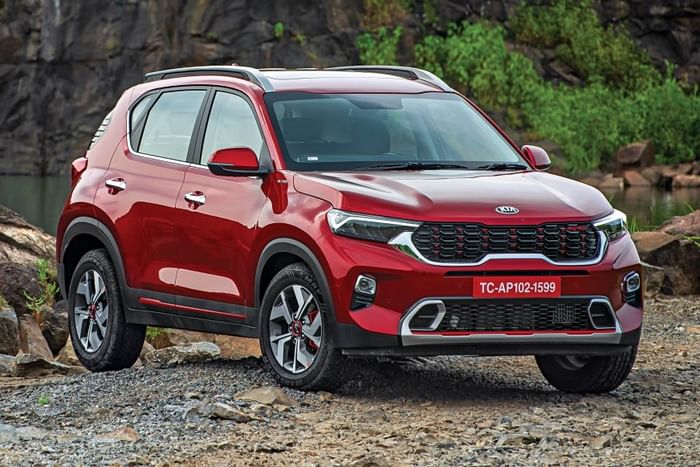
The front, of course, carries the signature Kia ‘Tiger Nose’ grille, which has a nice knurled and chrome-finished lower edge, and on the GT Line, there are some neat red accents too. The headlights are slim LED units with the signature ‘heartbeat’ DRL light design, and they sit atop a very sharply cut bumper that houses the fog lights and a faux skid plate. Topping off the front, the bonnet has a nice and subtle power bulge.
The side is where you’d expect there to be some similarity to the Venue, but here too Kia has gone with a completely different style. The doors are different with a more rounded profile, and defining the Sonet’s silhouette is a C-pillar that appears swept back, thanks to the inset quarter glass and the black-out treatment on the top and lower edges. The alloys are also quite striking and have a lot of sharp cuts, though to some they may come off as a bit over the top.
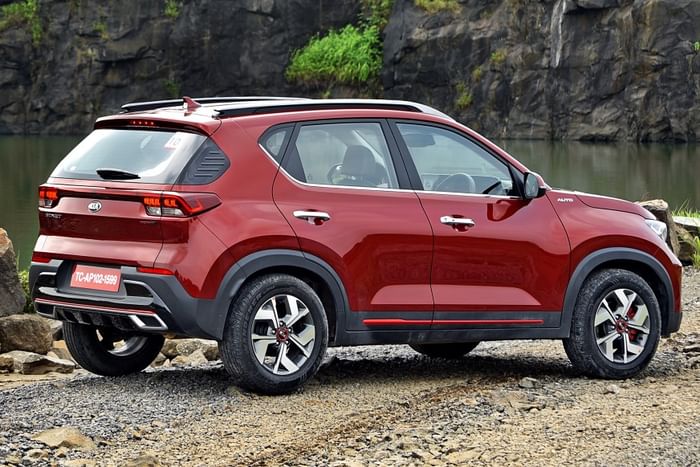
At the rear, the integrated spoiler carriers the high-mounted stop light and the tail-lights also have the ‘heart beat’ DRL signature, which extends neatly into a reflector unit stretching right across the bootlid. A faux skid plate with an integrated faux diffuser and dummy exhausts round off the rear end.
What’s the Kia Sonet’s interior like?
In terms of interior space, it’s no surprise the Sonet is similar to the Venue, and that means space is not class leading. Like with the Venue, the rear seat is relatively cramped and best for two not-too-tall passengers. The rear seat itself is quite comfy, with plush padding, though thigh support is a bit short. Up front, it’s a different story. The front seats are large, well bolstered and ventilated which, in peak summer, is a big plus.

Where the Sonet really scores is with cabin quality. The choice of materials used gives a quality feel that’s not just better than rivals (the Venue included), but also cars of a segment above. The richly textured dashboard top, the chunky steering wheel with superbly crafted buttons, and the overall tactile feel of all the switchgear are top class. Personally, I’m not a fan of the central air-con vents’ look, but love the way they adjust with a solid and damped feel. I’m also not a fan of the digital instrument cluster and would have preferred a traditional needle to display speed, but I suppose it’s been designed for the new ‘digital’ customer.
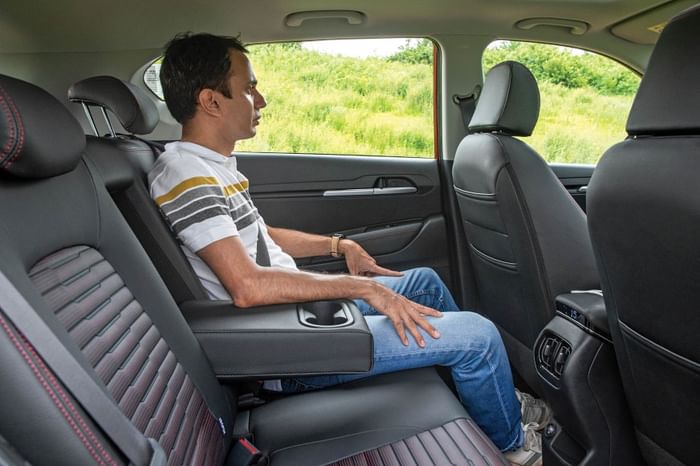
Taking centre stage in the cabin is the massive touchscreen (borrowed from the Seltos), which at 10.25 inches, is the largest in class. It’s sharp, easy to operate and offers a split screen function, letting you run both Android Auto as well as some of the Sonet’s own OS’s functions.
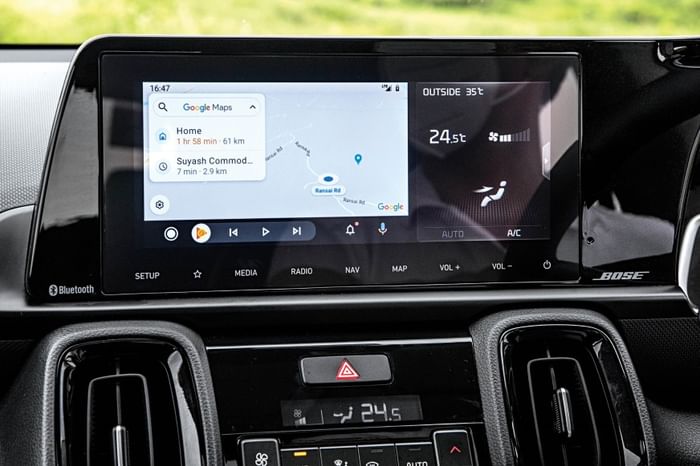
This brings us to the Sonet’s feature list. With the amount on offer, it’s clear the Korean carmaker is aiming to have the most extensive list. There are all of the expected bits, like auto climate control, a sunroof and wireless phone charging. But what really sets the Sonet apart, other than the massive touchscreen, is a brilliant-sounding 7-speaker Bose audio system, a perfume dispenser, and an air purifier that Kia says gets rid of bacteria and viruses with UVC light and a HEPA filter – just what the doctor ordered in these COVID times.
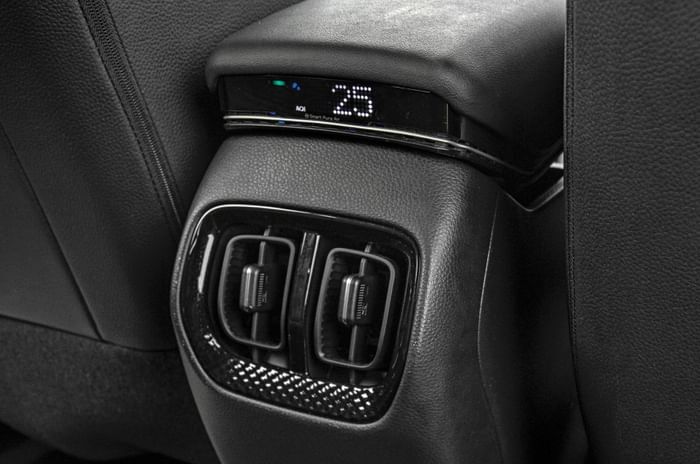
Another impressive feature is the ‘Hello Kia’ voice command that lets you simply talk to the car to set things like AC temperature and lower the windows, which is quite handy at toll plazas. As with most voice assistants these days, you don’t have to learn a specific command, as the system recognises a few conversational phrases. Kia’s UVO connectivity is also present, with functionality offered via smartphone or smartwatch too. In terms of safety, the Sonet is well kitted out, offering six airbags, ABS and ESC, Hill start Assist Control, front and rear parking sensors and emergency braking warning.
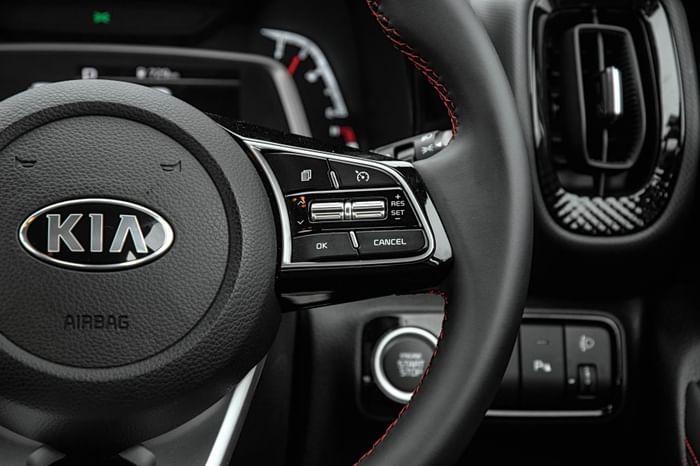
Should you buy a Kia Sonet?
Seldom does a manufacturer speak of targeted sales volumes, rarer still for them to do so a couple of months before the model’s actual launch. But such is the confidence Kia has in its latest product, it has revised the Sonet’s sales target upwards from 70,000 units to 1,00,000, and that too in the midst of a pandemic! So is the company’s faith well-placed?
Aside from the not-so-spacious back seat, it’s hard to fault the Sonet. It’s beautifully styled with good proportions and lots of striking details, the interiors are very well appointed, finished to a high order and packed with features, many of which are first in class. It’s also effortless and very enjoyable to drive, and the diesel auto overshadows the turbo-petrol in almost every way; it’s absolutely brilliant. There are also other powertrain options to choose from, depending on your budget.
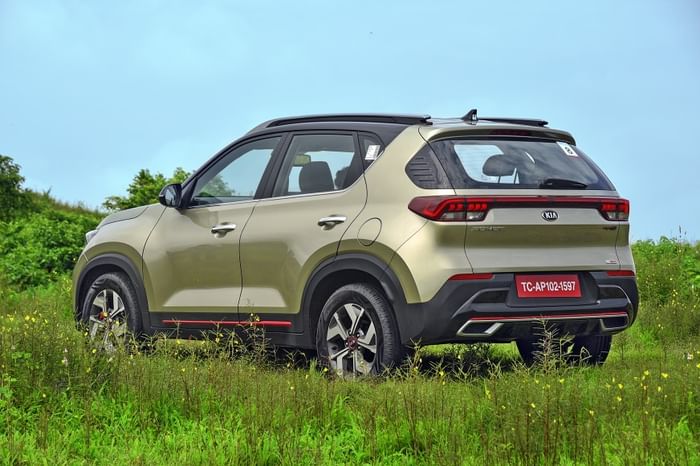
Of course, the pricing is a key factor in the Sonet’s ultimate success, but after what we’ve seen and driven, there’s no doubt that Kia has another winner on its hands.







































